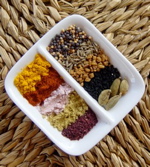Maui Island Taro with an Ayurvedic Twist
 Taro, or Karo in traditional Hawaiian language, is a vegetable rich in history and cultural significance. Hawaiian lore tells the story of the Sky father Wakea and his Daughter Ho'ohokukalani who birthed a stillborn child. The chld was buried near their home. A stalk shot up from this place growing into a large plant with deep roots. This plant was named Haloanaka which means "long stalk tembling." Eventually, a second child was born to Wakea and Ho'ohokukalani, this child became human and from him all other humans have come. Karo is mankind's older brother. Watching over and sustaining the human race.
Taro, or Karo in traditional Hawaiian language, is a vegetable rich in history and cultural significance. Hawaiian lore tells the story of the Sky father Wakea and his Daughter Ho'ohokukalani who birthed a stillborn child. The chld was buried near their home. A stalk shot up from this place growing into a large plant with deep roots. This plant was named Haloanaka which means "long stalk tembling." Eventually, a second child was born to Wakea and Ho'ohokukalani, this child became human and from him all other humans have come. Karo is mankind's older brother. Watching over and sustaining the human race.
This nutritious and versitile starchy food can be prepared in many ways which include baking, frying into chips, boiling and mashing into poi. Below we have included a recipe from Meta Doherty, author of Ayurvedic literature, Satwa Cafe (a cookbook) and Forever Wellbeing (a lifestyle book). Enjoy!
TARO ROUNDS
Diet affects the mind, affects the way we perceive things.
1 taro, 500 gm = 1 lb
The Seasonings
1/4 tsp black peppercorns
1/2 tsp aniseed
1/4 tsp ginger
1 tbsp ghee or coconut oil
a sprinkle of earth or sea salt
fresh coriander
lemon wedges
1. Create a bed of coals for traditional preparation. Otherwise preheat oven to 375°F (190°C, Gas 5).
2. Surround taro by coals and bake for 1 hour, or until knife is easy to insert. If using an oven, bake for 75 minutes and then test with a knife.
3. Meanwhile, warm a small skillet over medium low heat and add whole peppercorns. Dry roast for 1 minute and transfer to mortar. Add aniseed to skillet while you grind the pepper. After 1 minute add the aniseed to mortar and grind, now adding the ginger powder.
4. Warm the ghee or oil in the same skillet over medium low heat and add the mortar mix. Sauté for 2 minutes, then remove from heat and add the salt.
5. Chop the fresh coriander.
6. When the taro is thoroughly cooked, slice into rounds and remove peel with a knife.
7. Place on a platter and garnish with the skillet mix and fresh coriander. Pass the lemon at the table.
Serves 2 as a side dish. Choose a larger taro for more people and increase baking time and seasonings accordingly. Polynesian-Hawaiian-Caribbean Influence.
Of this recipe
Kapha, enjoy less; use potato instead of taro, less ghee and a few drops of lemon; the spices are good with any food or as a digestive tea using 1/4 teaspoon of the mix.
Pitta, enjoy some; use less skillet spices in the same amount of ghee; use a few drops of lemon.
Vata, enjoy more; a small amount of the spices are also good as a digestive tea.
TARO IS BAKED AND COATED WITH A TRADITIONAL DIGESTIVE TRIO OF SPICES.